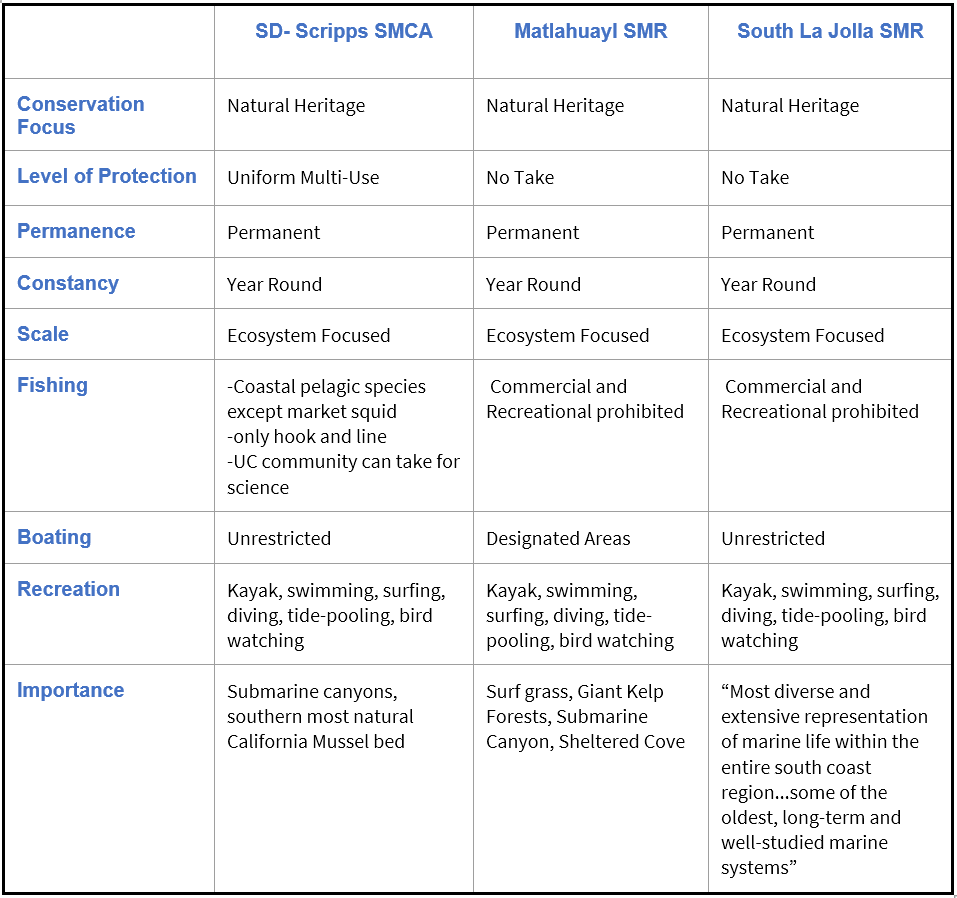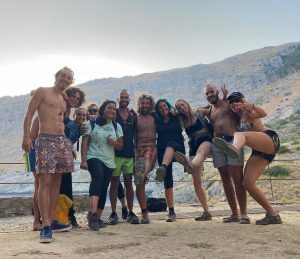Protected Areas in the USA
MPA National System

The National System of Marine Protected Areas of the United States (est. in April 2009) is a national initiative designed to strengthen the protection of U.S. ocean, coastal, and Great Lakes resources through the coordination of existing marine protected areas.
MPA’s protect ecosystems such as coral reefs, kelp forests, shipwrecks, and those areas frequented by whales and other marine life. They also can provide protection to economically valuable coastal and marine resources including commercial and recreational fisheries.
History
- 1903 – First MPA was established, Pelican Island National Wildlife Refuge
- 2000 – National System of Marine Protected Areas and the National Marine Protected Area Center are established
- 2006 – Papahānaumokuākea Marine National Monument in Hawai’i, the largest MPA, is established
- 2013 – 1,700 MPA’s have been established covering 41% of marine waters

Levels of MPA’s
The national system of MPA’s are established and managed by the following governments:

- State/2Territorial (77%)
- Federal (15%)
- Tribal
- Local
The MPA’s are further broken down into:
- State Marine Conservation Areas (can be take or no-take)
- State Marine Reserves (always no-take)
- Special closures (for fisheries)
- Federal Marine Conservation Areas
- Federal Marine Reserves
These collections of MPA’s work together to collectively enhance conservation of the nation’s marine heritage and important natural and cultural resources.
Improvements Provided by the National System
The national system of MPA’s provides the first comprehensive mechanism for coordinating MPAs to work toward national conservation objectives. Examples of some of these benefits include:
- Enhanced stewardship through better coordination, public awareness and enhanced site management capacity
- Building partnerships for MPA’s to work together toward common conservation objectives
- Increased support for marine conservation through the recognition provided by the national system
- Protecting representative ecosystems and resources from all the nation’s ecosystem and habitat types
- Identifying gaps in current protection of ocean resources to help inform future MPA planning
MPA Diversity
The U.S. has more than 1700 MPA’s covering more than 41% of U.S. marine waters, and vary widely in purpose, legal authorities, managing agencies, management approaches, level of protection, and restrictions on human uses.
Some highlights:
- State and territorial governments manage approximately 75% of the nation’s MPA’s, but most MPA areas are managed by federal agencies
- The majority of U.S. MPA’s are located within the Virginian Atlantic marine ecoregion, which extends along Cape Hatteras northward to Cape Cod
- Nearly all (86%) of U.S. MPA’s are multiple use

What kind of MPA’s are there?
The National Marine Protected Areas Center has developed a Classification System that describes MPA’s in functional terms using five characteristics common to most MPA’s:
- Conservation focus – Natural Heritage or Cultural Heritage
- Level of protection
- Uniform multiple-use, zoned multiple-use, zoned multiple-use with no-take areas, no impact, no take, no access
- 86% are multiple-use while less than 8% are no-take
- Permanence of Protection – Permanent or Conditional
- Constancy of Protection – Year-Round or Seasonal
- Scale of Protection – Ecosystem Focused or Resource Focused
Marine Reserves:
Marine reserves are rare in the United States, with about 3% of U.S. waters in no-take areas. Reserves protect whole ecosystems, allowing them to return toward a more natural and balanced state.
Nearly 94 percent of marine reserve area in the U.S. is located in the Papahānaumokuākea Marine National Monument in Hawaii.
The remaining 6 percent is located in small reserves around the country. Marine reserves are established through the existing authorities of federal agencies, states or territories.
Where are they located?
The West Coast (California, Oregon, and Washington) has the highest number of MPA’s. For example:

- In La Jolla, San Diego, California
- San Diego-Scripps Coastal State Marine Conservation Area
- Matlahuayl State Marine Reserve
- South La Jolla State Marine Reserve
- All established in 2012
- All Natural Heritage, Ecosystem Focused, Permanent, Year-Round MPA’s

However, the region with the largest area of MPA’s is the Pacific Islands. This is because of the Papahānaumokuākea Marine National Monument, which is the largest marine conservation area in the world.

Most of the Great Lakes MPA’s were created to protect cultural resources, like shipwrecks and historical artifacts. One example of a Great Lakes MPA is the Thunder Bay National Marine Sanctuary, which protects more than over 150 shipwrecks.
Ex: The Papahānaumokuākea Marine National Monument
The Papahānaumokuākea Marine National Monument is not only the largest conservation area in the U.S., it’s one of the largest marine conservation areas in the world. It’s larger than all of America’s national parks combined! This vast region preserves many of Hawaii’s Northwestern Islands and is made up of 582,578 square miles of reefs, atolls, shallow waters, and deep seas.
The monument contains a wide variety of critically important habitats that harbor over 7,000 marine species, several of which are only found in this region. It is also home to many rare and endangered species such as the green sea turtle and the Hawaiian monk seal.
Important species that benefit from these MPA’s
- Giant Kelp: Macrocystis pyrifera
- Provides important habitat for hundreds of species, some of which specifically evolved to live in these kelp forests
- As a primary producer it provides a significant amount of energy for the ecosystem

- California Sea Lion: Zalophus californianus
- Important as a top predator
La Jolla Cove – protected cove in Matlahuayl SMR; popular haul-out spot for the California Sea Lion (pictured) and harbor seal

- Leopard Sharks : Triakis semifasciata
- Utilize the warm, shallow, coastal waters along the MPAs to gather together during breeding season
- Can even snorkel over them!

- California Sheephead : Semicossyphus pulcher
- The California state fish! Lives in kelp forests
- Is protogynous – all are born female and at some point in their life they transition to male

- Grunion Fish : Leuresthes tenuis
- Converge on the beaches along the MPAs to breed at night

MPA Science
Scientific understanding of MPA’s is growing rapidly. Research has shown that MPA’s are effective at increasing the abundance and diversity of marine life within their boundaries. In order to gain support from and build trust with MPA stakeholders, MPA managers and planners rely on natural and social science for the design and management of these special areas.
Findings:
- MPA’s assisted in rebuilding the Georges Bank sea scallop fishery west of Cape Cod (MA) and the rotational reopening of these areas contributed to the high scallop landings during the past decade or more” (Hart and Jacobson).
- “Underwater visual surveys for a no-take MPA north of Oahu, Hawai’i found that fish abundance and biomass were correlated with distance from the MPA boundary, showing a decreasing gradient from inside to outside, indicating a spillover of adult fish” (Tissot et al.)
- “MPA’s in the Bering Sea reduced red king crab bycatch but increased bycatch of halibut in adjacent waters from displaced fishermen, thus creating a situation where a closure intended to protect one vulnerable species (e.g., red king crab) may increase unintended fishing pressure on another (e.g., halibut)” (Abbott and Haynie)
Fun things to do in these MPA’s
- Kayaking
- you can kayak on your own or join in on one of the many guided kayak tours that will take you out in the Matlahuayl SMR to see sea lions and caverns
- Snorkel or Scuba Dive
- snorkel just about anywhere! A sea lion may come up to say hi, or snorkel over leopard sharks
- dive out to see in the underwater canyons in San-Diego Scripps SMCA and Matlahuayl SMR
- Tide Pooling
- Good tide-pooling can be found up and down the coast
- A great spot is Dike Rock in the San Diego-Scripps SMCA containing an incredible amount of diversity including sea anemones and nudibranch sea slugs
- Surf or Enjoy the Public Beaches
- See the Bioluminescent Spring Phytoplankton Bloom
- Due to coastal upwelling during the spring, there are many types of phytoplankton that grow like crazy
- Including the bioluminescent dinoflagellates













